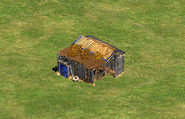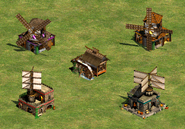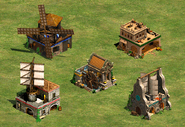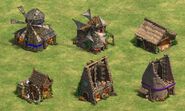| This article is about the building in Age of Empires II. For similar buildings in other games of the series, see Mill. |
| “ | Used to deposit food and research farming improvements. | ” |
| —Age of Empires II description | ||
The Mill is an economic building in Age of Empires II. It is a drop-off point for any kind of food that Villagers gathered. Also, Farming upgrades are researched here, and Farms can be queued.
While it appears that Poles do not have access to the Mill, behind the scenes the Mill is upgraded to the Folwark for free.
Tactics and placement[]
Mills are one of the most important buildings in the Dark Age as they are drop places for food. They should be placed near a rich source of food like Berry Bushes and Shore Fish. Building a Mill next to Wild Boars, Deer, or herdable animals is not always necessary, as these units can be lured/herded to the Town Center or an already built Mill. Villagers building a Mill drop off any resource they are holding at the Mill once it is built (not only food, but also wood, gold and stone). In later stages of the game, the Mill becomes less important, as usually all freely available food is gathered and enough Town Centers are built to produce enough food with Farms next to them.
In most matches, players use a Mill and a Lumber Camp as the required buildings to advance to the Feudal Age as that is the most cost effective way to cover that requirement (since both buildings only cost 100 wood address the most important resources in that early stage of the game). Having a Mill is also prerequisite to get access to Markets and Farms. Losing the Mill does not lose the access to the Market or Farm.
The possibility to queue Farms (since The Conquerors) is very handy as it saves the player time, especially in the busy early Castle Age when the Farms usually have to be renewed for the first time. Queued Farms have the same cost as normally built ones. So it is recommended to always have enough Farms in the queue so that Farmers never stand idling (given, of course, that enough wood is available). If there is a shortage of wood, Farms can also be unqueued.
The introduction of the automatic reseed button in the Definitive Edition brings more quality of life to the players, since it allows the player just to turn on the toggle for automatic reseed and let the farmer automatically reseed the Farm without the need to queue Farm for the rest of the game. This also allows better wood management, since the player doesn't have to pay the wood in advance.
Among all civilizations, the Gurjaras have the most crucial bonus for their Mills, as they can garrison up to ten Sheep or other herdable animals inside each Mill, which provides a food trickle income, scaling for more livestock with diminishing returns. Considering this, it is especially important for players playing as the Gurjaras to defend the Mills holding livestock in order to keep generating additional food, and to prevent enemies attacking the Mill from killing or taking the livestock.
Technologies[]
Clicking on the icon links to the corresponding page.

|

|
|||||||

|

|

|

| |||||
 |  | 
|
Upgrades[]
| Hit points | |
| Armor | |
| Line of Sight | |
| Conversion defense | |
| Construction speed | |
| Upgrades |
Civilization bonuses[]
 Burgundians: Mill technologies can be researched one Age earlier and cost -33% food.
Burgundians: Mill technologies can be researched one Age earlier and cost -33% food. Burmese: Researching Devotion and Faith is 50% cheaper.
Burmese: Researching Devotion and Faith is 50% cheaper. Byzantines: Mills have +10%/+20%/+30%/+40% hit points in the Dark/Feudal/Castle/Imperial Age. Town Watch and Town Patrol free.
Byzantines: Mills have +10%/+20%/+30%/+40% hit points in the Dark/Feudal/Castle/Imperial Age. Town Watch and Town Patrol free. Chinese: Technologies that benefit Mills and Mill technologies are 5%/10%/15% cheaper in the Feudal/Castle/Imperial Age.
Chinese: Technologies that benefit Mills and Mill technologies are 5%/10%/15% cheaper in the Feudal/Castle/Imperial Age. Franks: Mill technologies are free.
Franks: Mill technologies are free. Georgians: Mills receive -20% damage (-40% instead of -25%) when fighting from higher elevation.
Georgians: Mills receive -20% damage (-40% instead of -25%) when fighting from higher elevation. Gurjaras: Herdable animals (maximum 10) can be garrisoned in Mills to produce food.
Gurjaras: Herdable animals (maximum 10) can be garrisoned in Mills to produce food. Japanese: Mills are 50% cheaper.
Japanese: Mills are 50% cheaper. Malians: Mills are 15% cheaper.
Malians: Mills are 15% cheaper. Persians: Researching Town Watch and Town Patrol is 10%/15%/20% faster in the Feudal/Castle/Imperial Age.
Persians: Researching Town Watch and Town Patrol is 10%/15%/20% faster in the Feudal/Castle/Imperial Age. Poles: Mills are upgraded to Folwarks for free, which cost +25 wood and 5 seconds more to build, and also provide 5 housing space and collect 8% of food from nearby newly built Farms.
Poles: Mills are upgraded to Folwarks for free, which cost +25 wood and 5 seconds more to build, and also provide 5 housing space and collect 8% of food from nearby newly built Farms. Romans: Mills are built and repaired 5% faster.
Romans: Mills are built and repaired 5% faster. Spanish: Mills are built 30% faster. Researching technologies that benefit Mills provides 20 gold each.
Spanish: Mills are built 30% faster. Researching technologies that benefit Mills provides 20 gold each. Vietnamese: Mill technologies cost no wood and are researched 100% faster.
Vietnamese: Mill technologies cost no wood and are researched 100% faster.
Team bonuses[]
 Georgians: Mills cost 25% fewer resources to repair.
Georgians: Mills cost 25% fewer resources to repair. Lithuanians: Researching Devotion, Faith, and Heresy is 20% faster.
Lithuanians: Researching Devotion, Faith, and Heresy is 20% faster. Malians: Researching Masonry, Architecture, and Treadmill Crane is 80% faster.
Malians: Researching Masonry, Architecture, and Treadmill Crane is 80% faster. Portuguese: Technologies that benefit Mills and Mill technologies are researched 25% faster.
Portuguese: Technologies that benefit Mills and Mill technologies are researched 25% faster.
Changelog[]
 The Age of Kings[]
The Age of Kings[]
- Mills always have 1,000 hit points.
 The Conquerors[]
The Conquerors[]
 The Forgotten[]
The Forgotten[]
- Mill hit points staggered: 600/800/1,000/1,000 in the Dark/Feudal/Castle/Imperial Age.
 Definitive Edition[]
Definitive Edition[]
- Automatic reseed button introduced.
 Portuguese: With update 42848, Mill technologies are researched 30% faster.
Portuguese: With update 42848, Mill technologies are researched 30% faster. Vietnamese: With update 35584, Mill technologies cost no wood.
Vietnamese: With update 35584, Mill technologies cost no wood.
 Lords of the West[]
Lords of the West[]
 Burgundians: With update 47820, Mill technologies cost -50% food.
Burgundians: With update 47820, Mill technologies cost -50% food.
 Dawn of the Dukes[]
Dawn of the Dukes[]
 Dynasties of India[]
Dynasties of India[]
 Burgundians: With update 66692, Mill technologies cost -40% food.
Burgundians: With update 66692, Mill technologies cost -40% food.
 The Mountain Royals[]
The Mountain Royals[]
- With update 99311, Devotion was introduced.
History[]
| “ | One of the early industrial enterprises of the Middle Ages was the grinding Mill. Handed down from antiquity, this technology greatly sped the otherwise backbreaking process of grinding wheat and other grains into flour. Mills used water, wind, and animal power to turn the grinding stone. Grain was converted into flour and the mill owner kept a percentage of the flour as compensation. Mills might be owned by a local lord, a monastery, or a local entrepreneur. The profits of mills led to conflict and competition, and the right to grind grain for a community had to be paid for and defended. Millers could become modestly wealthy. They became part of the rising middle class of merchants and craftsmen that grew in importance as the Middle Ages progressed. | ” |
| —Age of Empires II manual | ||
Trivia[]
- The Native American Mill is a windmill featuring sails and wheel mechanisms; however, this is historically inaccurate, as they used wheels only for toys, not for machinery.
- The Dark Age Native American Mill is powered by a donkey like in all other civilizations, despite donkeys not being native to the Americas.
- The African Mill is the only one that is not a windmill or a water mill but retains the animal-powered mechanism after the Dark Age. In the Definitive Edition, after the Dark Age, the mill is powered by a Water Buffalo instead of a donkey.
- There are three main types of mills: windmills (the most common), water mills (used by Asian and Southeast Asian civilizations), and animal mills (shared by everyone in the Dark Age, but only used by the African civilizations after the Dark Age).
- The Indian and Central Asian Mill are based on the Nashtifan Windmills in Iran.
- The Mill is only one of three buildings that have an animation; the others are the Dock and Harbor and the Stable (only Southeast Asian Stables had animations before the Definitive Edition). This does not include the Fish Trap.
- The Mill-Folwark and Monastery-Fortified Church are the only upgrade pairs to have different costs.










